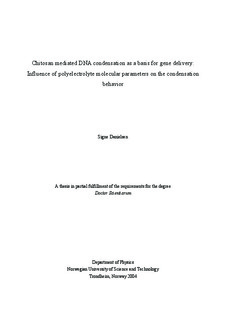| dc.contributor.author | Danielsen, Signe | nb_NO |
| dc.date.accessioned | 2014-12-19T13:16:02Z | |
| dc.date.available | 2014-12-19T13:16:02Z | |
| dc.date.created | 2008-02-08 | nb_NO |
| dc.date.issued | 2004 | nb_NO |
| dc.identifier | 123453 | nb_NO |
| dc.identifier.isbn | 82-471-6490-6 | nb_NO |
| dc.identifier.uri | http://hdl.handle.net/11250/246181 | |
| dc.description.abstract | Polycation mediated gene delivery has emerged as a promising alternative to the use of viral vectors for gene therapy. Although yielding significantly lower transfection efficiency than viral vectors, the use of polycations possess advantages over viruses such as reduced immune response and the possibility of carrying large DNAs at low cost. The polycations will condense DNA into a more compact form that may allow easier transport through the extracellular matrix and probably across the cell membrane, as well as protect the DNA from nuclease attacks. The non-toxic and biodegradable polycation chitosan has shown great potential as a gene delivery vehicle, as high transfection efficiencies are reported. In this study the effect of chitosan molecular parameters like charge density (determined by the fractional content of acetylated units, FA) and the degree of polymerization (DP) was evaluated for its ability to compact DNA. AFM-imaging revealed that chitosan compacted DNA into toroidal, rod-like and globular structures, with the dominant morphology depending on both FA and DP of the chitosan. Furthermore, when reducing the chitosan DP, larger chitosan concentrations were required to obtain DNA condensates of a well defined morphology. However, whereas high DP (HDP) chitosans could form well defined structures even at pH 7.4, chitosan oligomers were unable to compact DNA even at very high stoichiometric ratios. This indicates that a minimum chitosan charge is required to cause DNA collapse. Studying other polyanion-polycation systems revealed that general electrostatics is important for the complex formation. Furthermore, employing polyanions with different chain stiffness (xanthan, DNA and alginate) and using different polycations (chitosan and poly-L-lysine) as condensation agents showed that the morphologies formed are to a large extent determined by the chain stiffness of the polyanion, as well as properties of the polycation which is believed to affect the intersegment interaction energy. The stability of the delivery system is identified to be important for its ability to mediate high transfection levels. Whereas high stability is required for the transport of the delivery system towards the cell, and intracellularly towards the nucleus, DNA needs to be released inside the cell to be expressed. The ability of the DNAchitosan complexes to release DNA upon exposure to competing polyanions was identified to depend on the chitosan DP and concentration, as well as the properties of the competing polyanion. The glycosaminoglycans (GAGs) heparin and hyaluronic acid (HA) represent such competing polyanions. Whereas HA was unable to dissociated the DNA-chitosan complexes, exposure to heparin yielded a dissociation that depended on both the chitosan chain length and concentration. Both increasing chitosan concentration and DP resulted in complexes that were more resistant towards dissociation. Furthermore, increased stability of the complexes was obtained upon increasing the temperature of the DNA-chitosan system. Thus, by controlling the chitosan molecular parameters such as FA and DP, as well as the temperature in the system, it appears that both the morphology and the stability of the resulting DNAchitosan complexes can be tuned. Such knowledge is of importance when attempting to optimize this system for gene delivery purposes. | nb_NO |
| dc.language | eng | nb_NO |
| dc.publisher | Fakultet for naturvitenskap og teknologi | nb_NO |
| dc.relation.ispartofseries | Doktoravhandlinger ved NTNU, 1503-8181; 2004:133 | nb_NO |
| dc.relation.haspart | Danielsen, Signe; Vårum, Kjell M; Stokke, Bjørn T. Structural Analysis of Chitosan Mediated DNA Condensation by AFM: Influence of Chitosan Molecular Parameters. Biomacromolecules. 5(3): 928-936, 2004. | nb_NO |
| dc.relation.haspart | Danielsen, Signe; Strand, Sabine; Davies, Catharina de Lange; Stokke, Bjørn T. Glycosaminoglycan destabilization of DNA–chitosan polyplexes for gene delivery depends on chitosan chain length and GAG properties. Biochimica et Biophysica Acta (BBA) - General Subjects. 1721(1-3): 44-54, 2005. | nb_NO |
| dc.relation.haspart | Maurstad, Gjertrud; Danielsen, Signe; Stokke, Bjørn T. Analysis of Compacted Semiflexible Polyanions Visualized by Atomic Force Microscopy: Influence of Chain Stiffness on the Morphologies of Polyelectrolyte Complexes. J. Phys. Chem. B. 107(32): 8172-8180, 2003. | nb_NO |
| dc.relation.haspart | Danielsen, Signe; Maurstad, Gjertrud; Stokke, Bjørn T. DNA-polycation complexation and polyplex stability in the presence of competing polyanions. Biopolymers. 77(2): 86-97, 2005. | nb_NO |
| dc.relation.haspart | Danielsen, Signe; Oroudjev, Emin; Gutsmann, Thomas; Stokke, Bjørn T; Hansma, Helen G. Chitosan-mica interactions by force spectroscopy: a model system for DNA-chitosan condensation. . | nb_NO |
| dc.title | Chitosan-mediated DNA condensation as a basis for gene delivery: Influence of polyelectrolyte molecular parameters on the condensation behaviour | nb_NO |
| dc.type | Doctoral thesis | nb_NO |
| dc.contributor.department | Norges teknisk-naturvitenskapelige universitet, Fakultet for naturvitenskap og teknologi, Institutt for fysikk | nb_NO |
| dc.description.degree | dr.scient. | nb_NO |
| dc.description.degree | dr.scient. | en_GB |
